Surface Uniformity of Wafer-Scale 4H-SiC Epitaxial Layers Grown under Various Epitaxial Conditions
Abstract
:1. Introduction
2. Materials and Methods
3. Results and Discussion
3.1. C/Si Ratio
3.2. Growth Temperature
3.3. Si/H Ratio
4. Conclusions
Author Contributions
Funding
Institutional Review Board Statement
Informed Consent Statement
Data Availability Statement
Conflicts of Interest
References
- Kimoto, T. Material Science and Device Physics in SiC Technology for High-Voltage Power Devices. Jpn. J. Appl. Phys. 2015, 54, 040103. [Google Scholar] [CrossRef]
- Zhao, Z.; Li, Y.; Xia, X.; Wang, Y.; Zhou, P.; Li, Z. Growth of High-Quality 4H-SiC Epitaxial Layers on 4° off-Axis C-Face 4H-SiC Substrates. J. Cryst. Growth 2020, 531, 125355. [Google Scholar] [CrossRef]
- Kaloyeros, A.E.; Goff, J.; Arkles, B. Defect- and H-Free Stoichiometric Silicon Carbide by Thermal CVD from the Single Source Precursor Trisilacyclohexane. Electron. Mater. 2022, 3, 3. [Google Scholar] [CrossRef]
- He, Y.; Yuan, Z.; Song, S.; Gao, X.; Deng, W. Investigation on Material Removal Mechanisms in Photocatalysis-Assisted Chemical Mechanical Polishing of 4H–SiC Wafers. Int. J. Precis. Eng. Manuf. 2021, 22, 951–963. [Google Scholar] [CrossRef]
- Sako, H.; Kobayashi, K.; Ohira, K.; Isshiki, T. Microstructure of Stacking Fault Complex/Carrot Defects at Interface Between 4H-SiC Epitaxial Layers and Substrates. J. Electron. Mater. 2020, 49, 5213–5218. [Google Scholar] [CrossRef]
- Niu, Y.-X.; Tang, X.-Y.; Jia, R.-X.; Sang, L.; Hu, J.-C.; Yang, F.; Wu, J.-M.; Pan, Y.; Zhang, Y.-M. Influence of Triangle Structure Defect on the Carrier Lifetime of the 4H-SiC Ultra-Thick Epilayer. Chin. Phys. Lett. 2018, 35, 077103. [Google Scholar] [CrossRef]
- Nakamura, S.; Kimoto, T.; Matsunami, H. Rate-Determining Process in Chemical Vapor Deposition of SiC on off-Axis α-SiC (0001). J. Cryst. Growth 2004, 270, 455–461. [Google Scholar] [CrossRef]
- Feng, X.; Chen, Z.; Ma, J.; Zan, X.; Pu, H.; Lu, G. Epitaxial Growth of Cubic Silicon Carbide on Silicon by Sublimation Method. Opt. Mater. 2003, 23, 39–42. [Google Scholar] [CrossRef]
- Dhanaraj, G.; Dudley, M.; Chen, Y.; Ragothamachar, B.; Wu, B.; Zhang, H. Epitaxial Growth and Characterization of Silicon Carbide Films. J. Cryst. Growth 2006, 287, 344–348. [Google Scholar] [CrossRef]
- Kakuta, A.; Moronuki, N.; Furukawa, Y. Surface Properties of SiC Layer Grown by Molecular Beam Epitaxy (MBE) with Helicon Sputtering Molecular Beam Source. JSME Int. J. Ser. C Mech. Syst. Mach. Elem. Manuf. 2004, 47, 123–128. [Google Scholar] [CrossRef]
- Meli, A.; Muoio, A.; Trotta, A.; Meda, L.; Parisi, M.; La Via, F. Epitaxial Growth and Characterization of 4H-SiC for Neutron Detection Applications. Materials 2021, 14, 976. [Google Scholar] [CrossRef]
- Leone, S.; Pedersen, H.; Henry, A.; Kordina, O.; Janzén, E. Improved Morphology for Epitaxial Growth on 4° Off-Axis 4H-SiC Substrates. J. Cryst. Growth 2009, 311, 3265–3272. [Google Scholar] [CrossRef]
- Yazdanfar, M.; Ivanov, I.G.; Pedersen, H.; Kordina, O.; Janzén, E. Reduction of Structural Defects in Thick 4H-SiC Epitaxial Layers Grown on 4° off-Axis Substrates. J. Appl. Phys. 2013, 113, 223502. [Google Scholar] [CrossRef] [Green Version]
- Tsuchida, H.; Kamata, I.; Miyazawa, T.; Ito, M.; Zhang, X.; Nagano, M. Recent Advances in 4H-SiC Epitaxy for High-Voltage Power Devices. Mater. Sci. Semicond. Process. 2018, 78, 2–12. [Google Scholar] [CrossRef]
- Nishizawa, S.; Pons, M. Growth and Doping Modeling of SiC-CVD in a Horizontal Hot-Wall Reactor. Chem. Vap. Depos. 2006, 12, 516–522. [Google Scholar] [CrossRef]
- Liu, X.F.; Yan, G.G.; Liu, B.; Shen, Z.W.; Wen, Z.X.; Chen, J.; Zhao, W.S.; Wang, L.; Zhang, F.; Sun, G.S.; et al. Process Optimization for Homoepitaxial Growth of Thick 4H-SiC Films via Hydrogen Chloride Chemical Vapor Deposition. J. Cryst. Growth 2018, 504, 7–12. [Google Scholar] [CrossRef]
- Leone, S.; Pedersen, H.; Beyer, F.C.; Andersson, S.; Kordina, O.; Henry, A.; Canino, A.; La Via, F.; Janzén, E. Chloride-Based CVD of 4H-SiC at High Growth Rates on Substrates with Different Off-Angles. Mater. Sci. Forum 2012, 717–720, 113–116. [Google Scholar] [CrossRef]
- Leone, S.; Beyer, F.C.; Pedersen, H.; Kordina, O.; Henry, A.; Janzén, E. Growth of Smooth 4H-SiC Epilayers on 4° off-Axis Substrates with Chloride-Based CVD at Very High Growth Rate. Mater. Res. Bull. 2011, 46, 1272–1275. [Google Scholar] [CrossRef]
- Li, Y.; Zhao, Z.; Yu, L.; Wang, Y.; Zhou, P.; Niu, Y.; Li, Z.; Chen, Y.; Han, P. Reduction of Morphological Defects in 4H-SiC Epitaxial Layers. J. Cryst. Growth 2019, 506, 108–113. [Google Scholar] [CrossRef]
- Shi, Y.; Zakharov, A.A.; Ivanov, I.G.; Vinogradov, N.A.; Yazdi, G.R.; Syväjärvi, M.; Yakimova, R.; Sun, J. A Patterning-Free Approach for Growth of Free-Standing Graphene Nanoribbons Using Step-Bunched Facets of off-Oriented 4H-SiC (0001) Epilayers. J. Phys. Appl. Phys. 2020, 53, 115102. [Google Scholar] [CrossRef]
- Hu, J.; Jia, R.; Xin, B.; Peng, B.; Wang, Y.; Zhang, Y. Effect of Low Pressure on Surface Roughness and Morphological Defects of 4H-SiC Epitaxial Layers. Materials 2016, 9, 743. [Google Scholar] [CrossRef] [Green Version]
- Zhao, L.; Wu, H. A Correlation Study of Substrate and Epitaxial Wafer with 4H-N Type Silicon Carbide. J. Cryst. Growth 2019, 507, 109–112. [Google Scholar] [CrossRef]
- Daigo, Y.; Watanabe, T.; Ishiguro, A.; Ishii, S.; Moriyama, Y. Influence and Suppression of Harmful Effects Due to By-Product in CVD Reactor for 4H-SiC Epitaxy. IEEE Trans. Semicond. Manuf. 2021, 34, 340–345. [Google Scholar] [CrossRef]
- Li, J.; Meng, C.; Yu, L.; Li, Y.; Yan, F.; Han, P.; Ji, X. Effect of Various Defects on 4H-SiC Schottky Diode Performance and Its Relation to Epitaxial Growth Conditions. Micromachines 2020, 11, 609. [Google Scholar] [CrossRef]
- Hu, J.; Jia, R.; Niu, Y.; Zang, Y.; Pu, H. Study of a New Type Nominal “Washboard-like” Triangular Defects in 4H-SiC 4° off-Axis (0 0 0 1) Si-Face Homoepitaxial Layers. J. Cryst. Growth 2019, 506, 14–18. [Google Scholar] [CrossRef]
- Sun, Y.; Feng, G.; Kang, J.; Zhang, J.; Qian, W. Analysis and Reduction of Obtuse Triangular Defects on 150-Mm 4° 4H-SiC Epitaxial Wafers. J. Electron. Mater. 2018, 47, 5109–5112. [Google Scholar] [CrossRef]
- Yang, L.; Zhao, L.X.; Wu, H.W.; Liu, Y.; Ailihumaer, T.; Raghothamachar, B.; Dudley, M. Characterization and Reduction of Defects in 4H-SiC Substrate and Homo-Epitaxial Wafer. Mater. Sci. Forum 2020, 1004, 387–392. [Google Scholar] [CrossRef]
- Yang, L.; Zhao, L.X.; Wu, H.W. Effect of Temperature on Conversion of Basal Plane Dislocations to Treading Edge Dislocations during 4H-SiC Homoepitaxiy. J. Cryst. Growth 2020, 531, 125360. [Google Scholar] [CrossRef]
- Ito, M.; Storasta, L.; Tsuchida, H. Development of 4H–SiC Epitaxial Growth Technique Achieving High Growth Rate and Large-Area Uniformity. Appl. Phys. Express 2008, 1, 015001. [Google Scholar] [CrossRef]
- Dong, L.; Sun, G.S.; Yu, J.; Yan, G.G.; Zhao, W.S.; Wang, L.; Zhang, X.H.; Li, X.G.; Wang, Z.G. 10 × 100 Mm 4H-SiC Epitaxial Growth by Warm-Wall Planetary Reactor. Mater. Sci. Forum 2013, 740–742, 239–242. [Google Scholar] [CrossRef]
- Mauceri, M.; Pecora, A.; Litrico, G.; Vecchio, C.; Puglisi, M.; Crippa, D.; Piluso, N.; Camarda, M.; La Via, F. 4H-SiC Epitaxial Layer Grown on 150 Mm Automatic Horizontal Hot Wall Reactor PE106. Mater. Sci. Forum 2014, 778–780, 121–124. [Google Scholar] [CrossRef]
- Das, H.; Sunkari, S.G.; Oldham, T.; Casady, J.R.B.; Casady, J.B. High Uniformity with Reduced Surface Roughness of Chloride Based CVD Process on 100 mm 4° Off-Axis 4H-SiC. Mater. Sci. Forum 2012, 717–720, 93–96. [Google Scholar] [CrossRef]
- Sun, Y.Q.; Feng, G.; Li, Z.Y.; Lv, L.P.; Luo, J.Y.; Wu, J.B.; Li, Y.Y.; Zhang, J.H. 50 Μm-Thick 100 Mm 4H-SiC Epitaxial Layer Growth by Warm-Wall Planetary Reactor. Mater. Sci. Forum 2014, 778–780, 163–166. [Google Scholar] [CrossRef]
- Wan, J.W.; Loboda, M.J.; MacMillan, M.F.; Chung, G.Y.; Carlson, E.P.; Torres, V.M. Scaling of Chlorosilane SiC CVD to Multi-Wafer Epitaxy System. Mater. Sci. Forum 2007, 556–557, 145–148. [Google Scholar] [CrossRef]
- O’Loughlin, M.; Burk, A.; Tsvetkov, D.; Ustin, S.; Palmour, J.W. Advances in 3x150 Mm Hot-Wall and 6x150 Mm Warm-Wall SiC Epitaxy for 10kV-Class Power Devices. Mater. Sci. Forum 2016, 858, 167–172. [Google Scholar] [CrossRef]
- Ferro, G.; Chaussende, D.; Tsavdaris, N. Understanding Al Incorporation into 4H-SiC during Epitaxy. J. Cryst. Growth 2019, 507, 338–343. [Google Scholar] [CrossRef]
- Yan, G.G.; He, Y.W.; Shen, Z.W.; Cui, Y.X.; Li, J.T.; Zhao, W.S.; Wang, L.; Liu, X.F.; Zhang, F.; Sun, G.S.; et al. Effect of C/Si Ratio on Growth of 4H-SiC Epitaxial Layers on on-Axis and 4° off-Axis Substrates. J. Cryst. Growth 2020, 531, 125362. [Google Scholar] [CrossRef]
- Zhao, L.X.; Yang, L.; Wu, H.W. High Quality 4H-SiC Homo-Epitaxial Wafer Using the Optimal C/Si Ratio. J. Cryst. Growth 2020, 530, 125302. [Google Scholar] [CrossRef]
- Danielsson, Ö.; Karlsson, M.; Sukkaew, P.; Pedersen, H.; Ojamäe, L. A Systematic Method for Predictive in Silico Chemical Vapor Deposition. J. Phys. Chem. C 2020, 124, 7725–7736. [Google Scholar] [CrossRef] [Green Version]
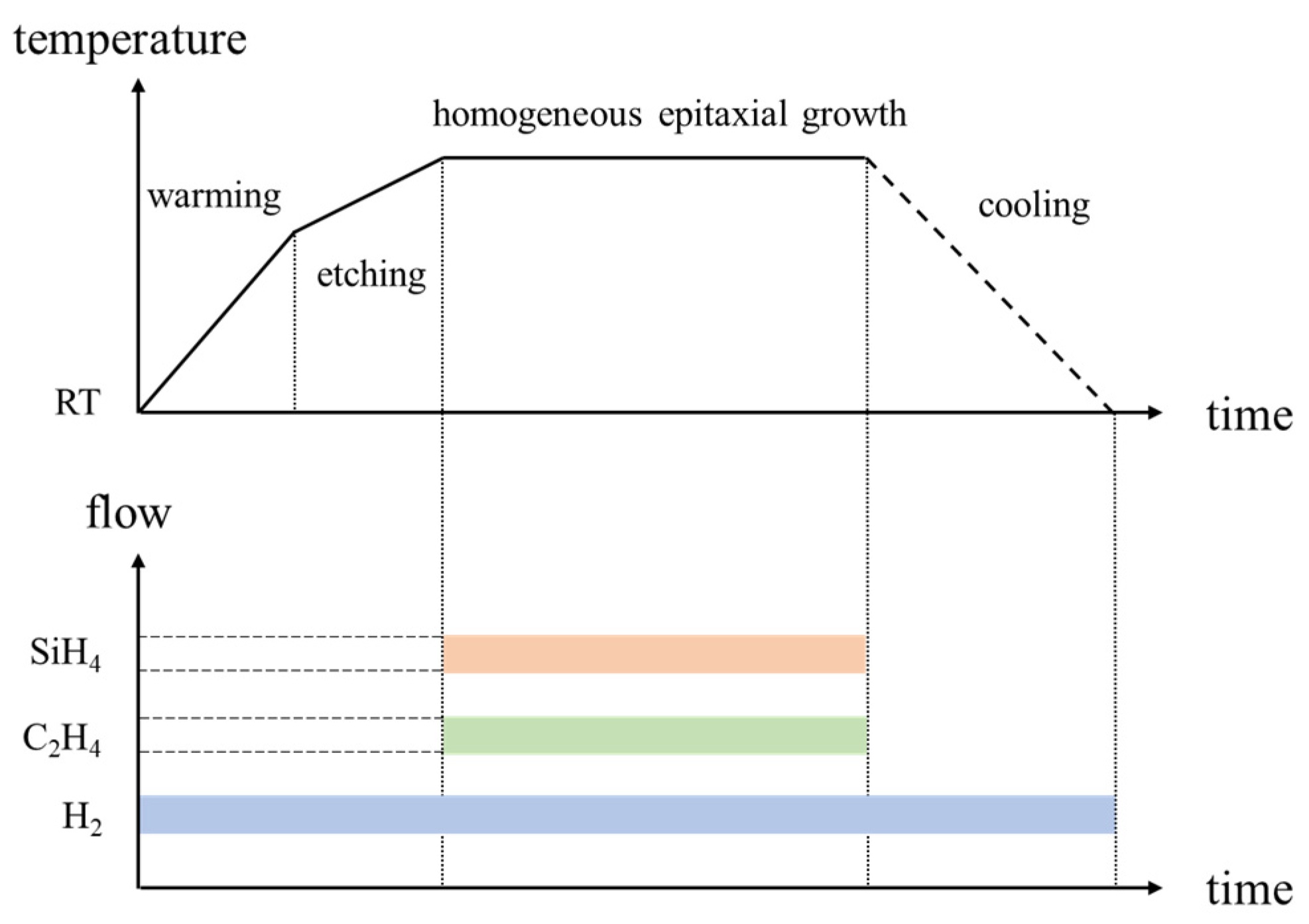
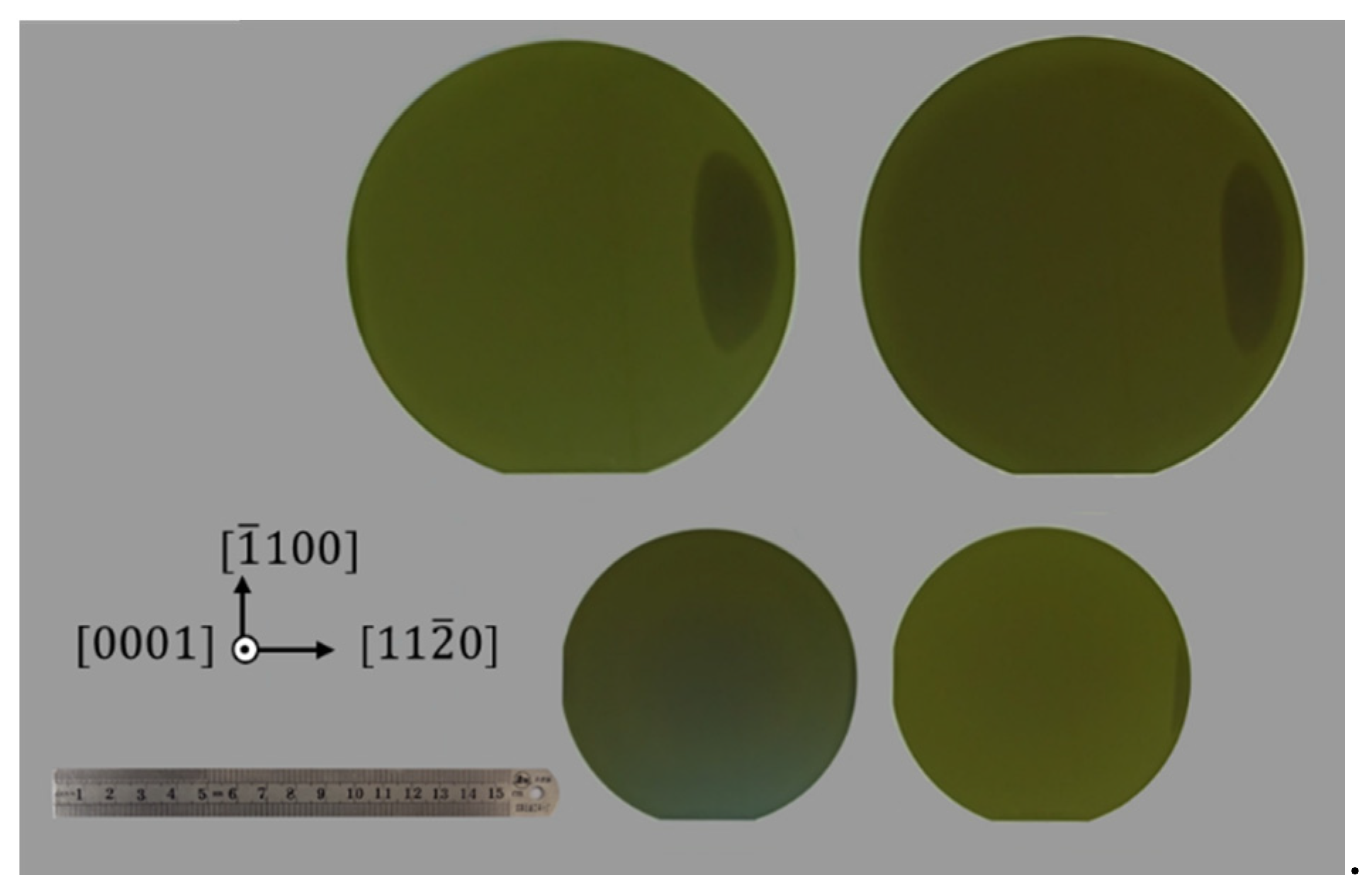
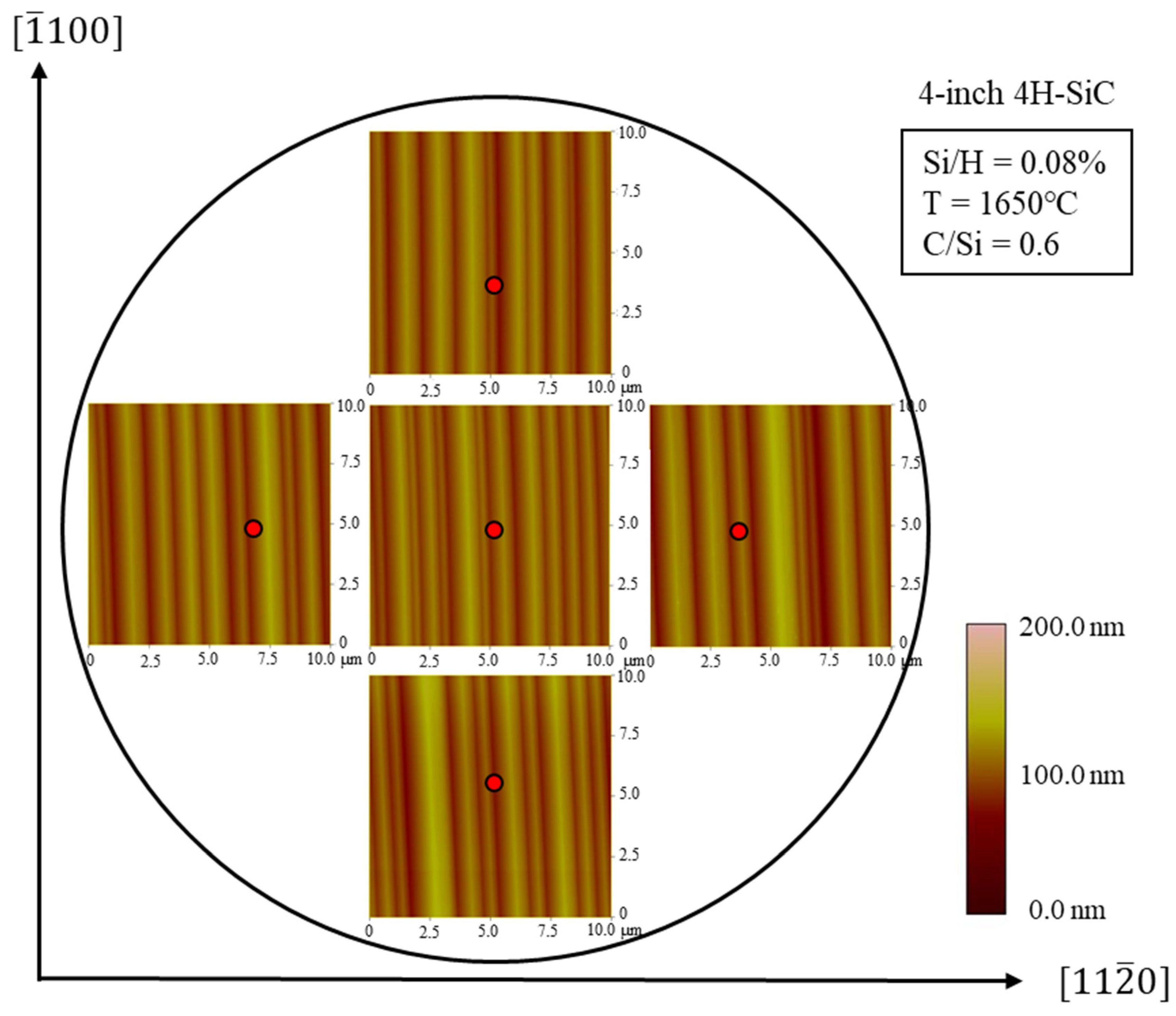




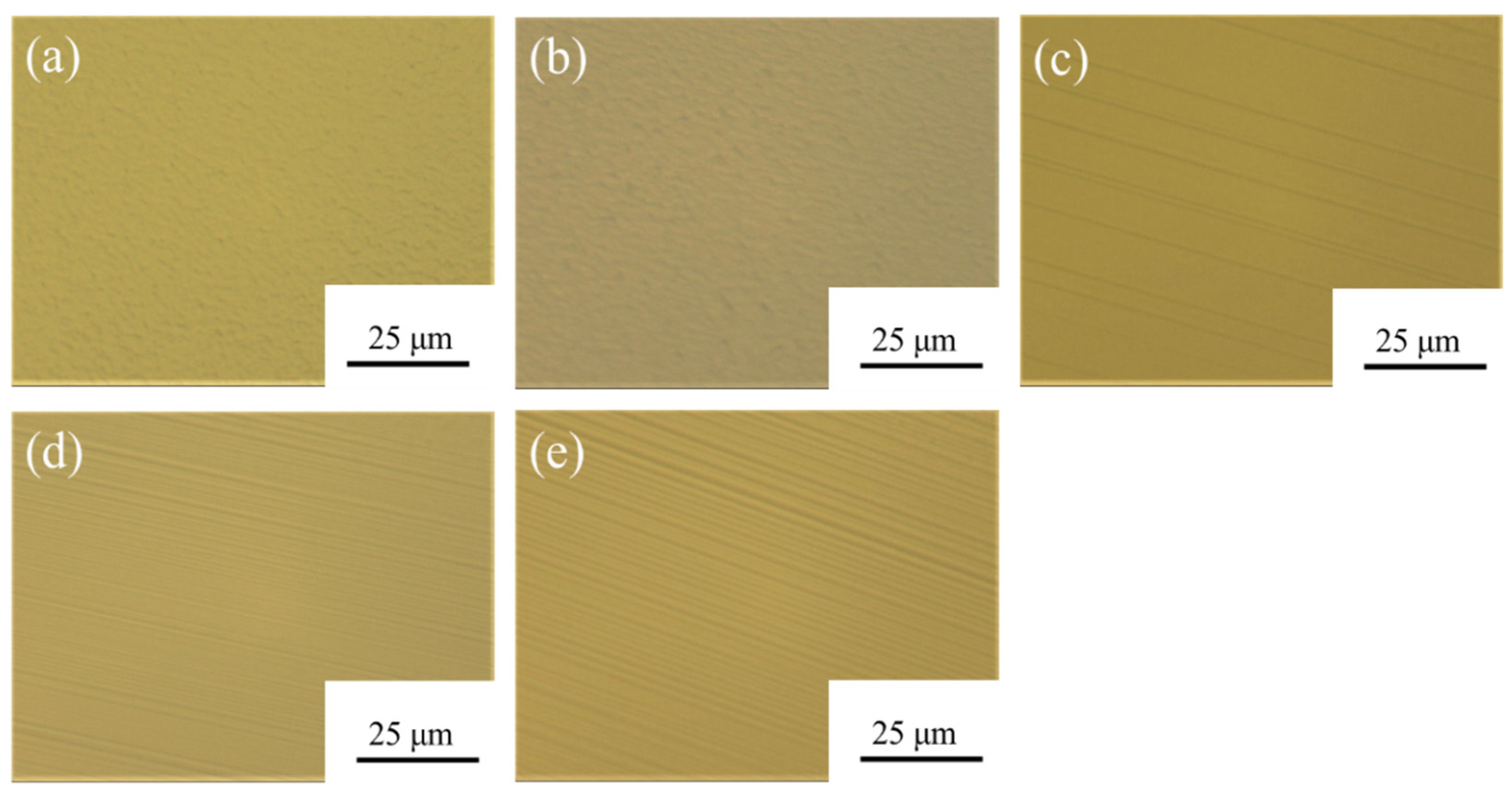
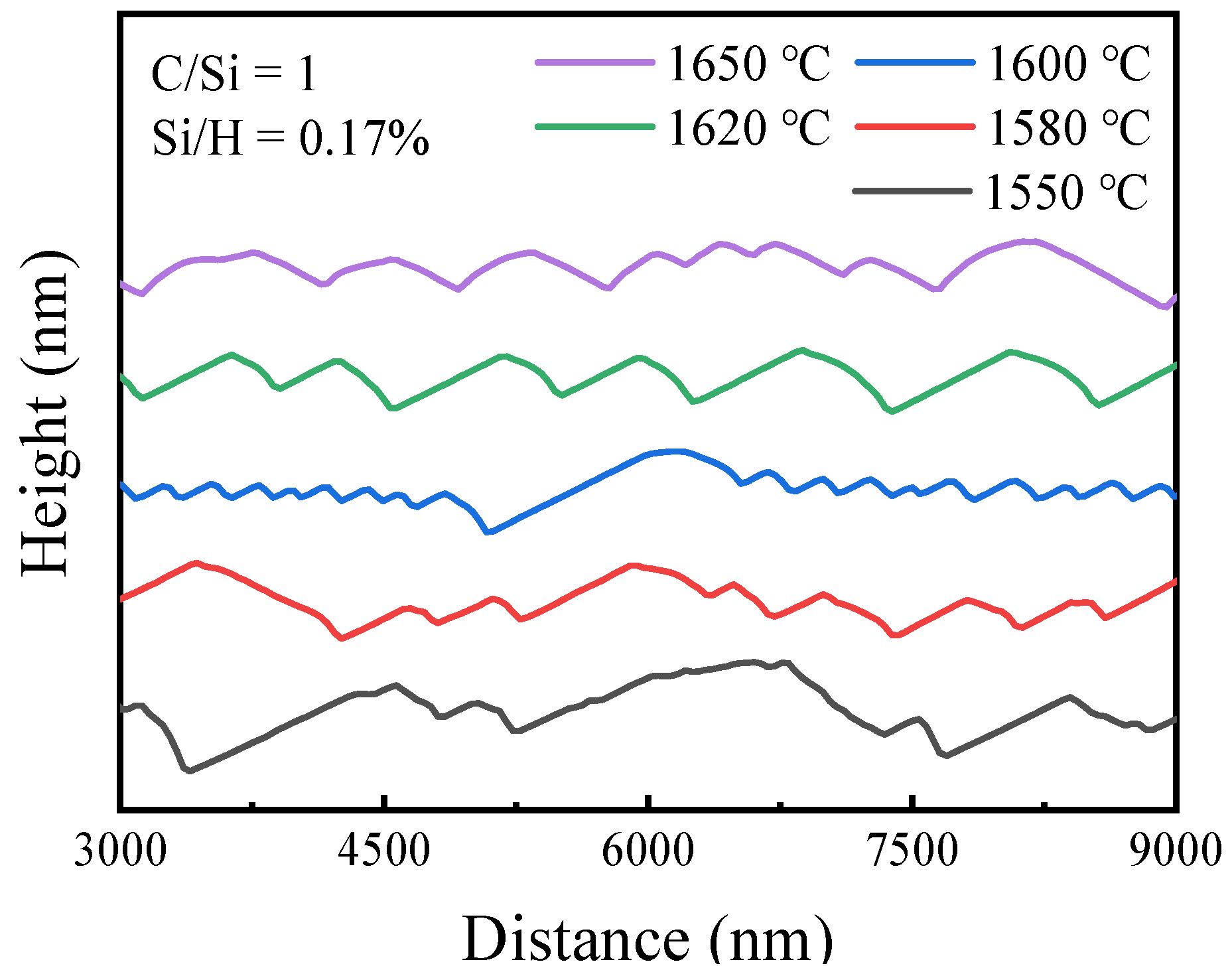
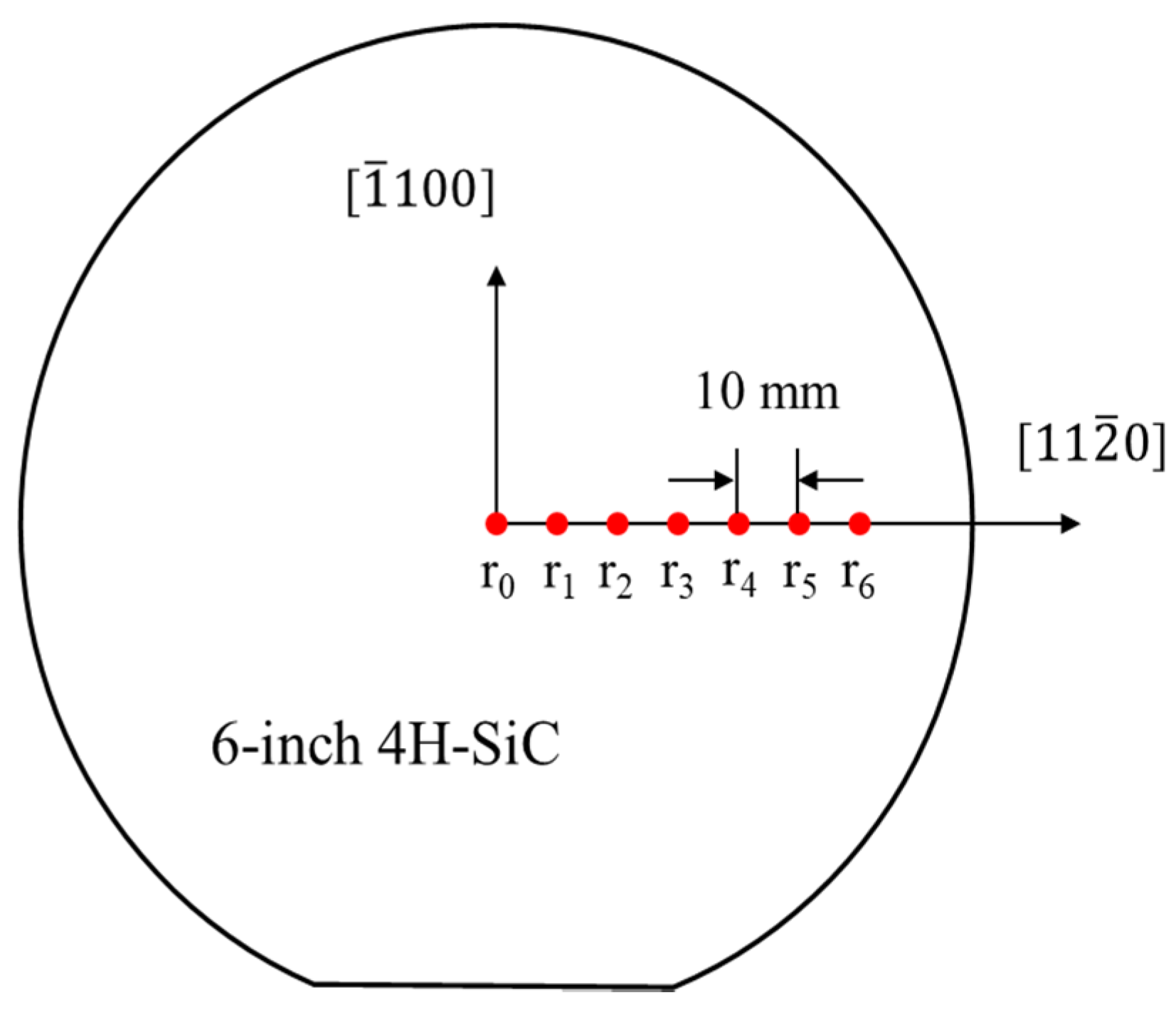
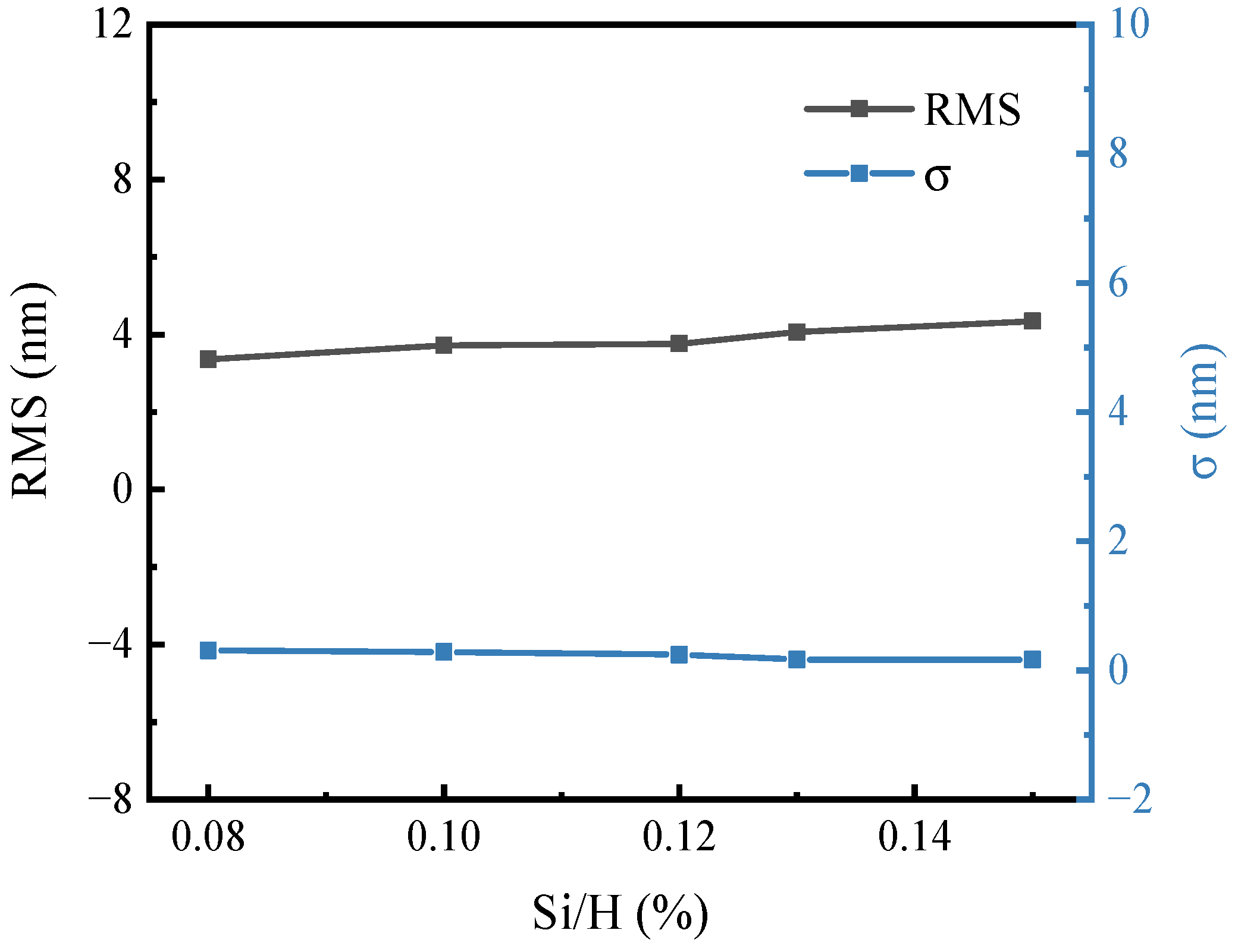
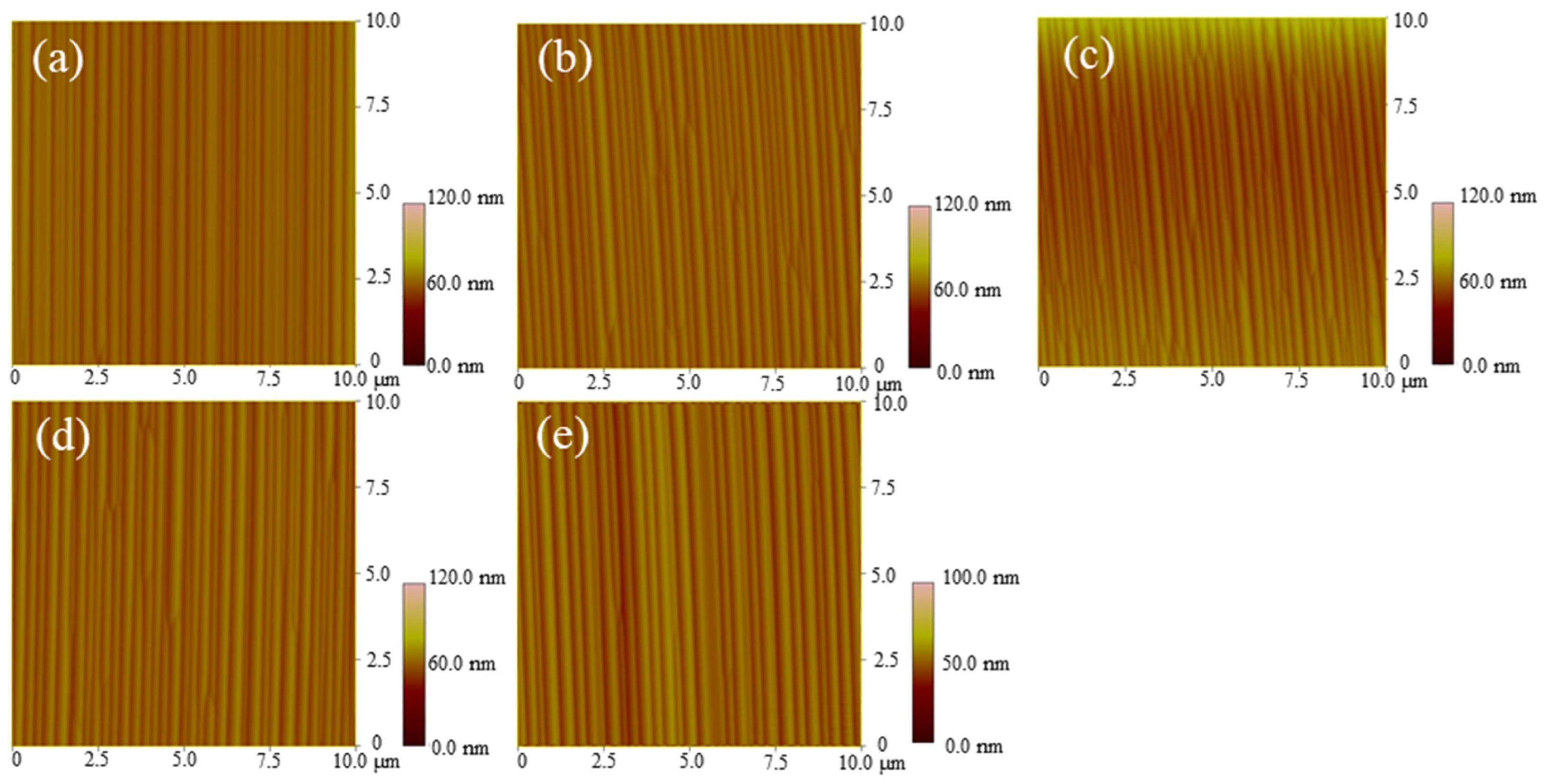
| Samples | r0 (nm) | r1 (nm) | r2 (nm) | r3 (nm) | r4 (nm) | r5 (nm) | r6 (nm) | σ |
|---|---|---|---|---|---|---|---|---|
| Si/H = 0.08% | 3.359 | 3.241 | 3.022 | 3.394 | 3.168 | 2.949 | 2.510 | 0.304 |
| Si/H = 0.10% | 3.718 | 4.031 | 3.700 | 3.998 | 3.804 | 3.367 | 3.292 | 0.285 |
| Si/H = 0.12% | 3.76 | 3.37 | 3.702 | 3.535 | 3.54 | 3.41 | 3.02 | 0.246 |
| Si/H = 0.13% | 4.061 | 4.198 | 3.963 | 4.256 | 4.176 | 3.800 | 3.926 | 0.166 |
| Si/H = 0.15% | 3.272 | 2.84 | 3.29 | 3.036 | 3.138 | 3.04 | 2.944 | 0.165 |
Publisher’s Note: MDPI stays neutral with regard to jurisdictional claims in published maps and institutional affiliations. |
© 2022 by the authors. Licensee MDPI, Basel, Switzerland. This article is an open access article distributed under the terms and conditions of the Creative Commons Attribution (CC BY) license (https://creativecommons.org/licenses/by/4.0/).
Share and Cite
Zhao, S.; Wang, J.; Yan, G.; Shen, Z.; Zhao, W.; Wang, L.; Liu, X. Surface Uniformity of Wafer-Scale 4H-SiC Epitaxial Layers Grown under Various Epitaxial Conditions. Coatings 2022, 12, 597. https://doi.org/10.3390/coatings12050597
Zhao S, Wang J, Yan G, Shen Z, Zhao W, Wang L, Liu X. Surface Uniformity of Wafer-Scale 4H-SiC Epitaxial Layers Grown under Various Epitaxial Conditions. Coatings. 2022; 12(5):597. https://doi.org/10.3390/coatings12050597
Chicago/Turabian StyleZhao, Siqi, Jiulong Wang, Guoguo Yan, Zhanwei Shen, Wanshun Zhao, Lei Wang, and Xingfang Liu. 2022. "Surface Uniformity of Wafer-Scale 4H-SiC Epitaxial Layers Grown under Various Epitaxial Conditions" Coatings 12, no. 5: 597. https://doi.org/10.3390/coatings12050597
APA StyleZhao, S., Wang, J., Yan, G., Shen, Z., Zhao, W., Wang, L., & Liu, X. (2022). Surface Uniformity of Wafer-Scale 4H-SiC Epitaxial Layers Grown under Various Epitaxial Conditions. Coatings, 12(5), 597. https://doi.org/10.3390/coatings12050597








